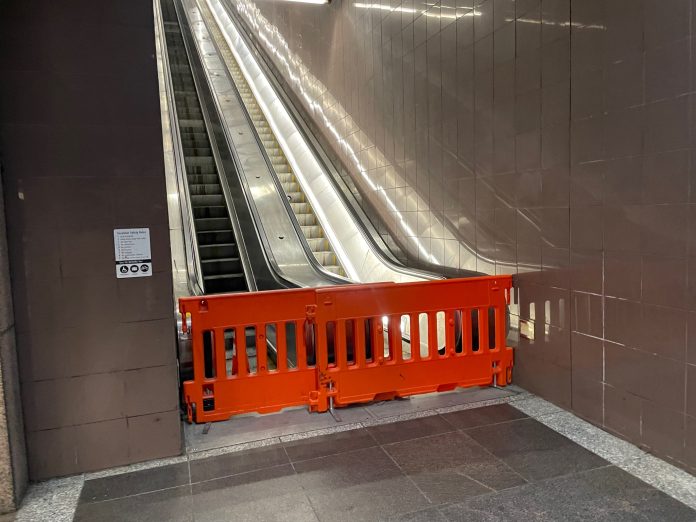The Sound Transit board is asleep at the wheel. Riders can see it clearly when they venture onto Link. Walk into any station and you will find trash collecting on platforms and tracks, in station hallways and escalator grates, and around unmaintained collection bins. Broken escalators and elevators? Check. Cracking platform tiles and leaking ceilings at brand new stations? Double check. Liquids and chips sloshing around trains and frequencies still lower than prior to the pandemic? Check, check, check. And it’s not just Link. Sounder’s getting steamrolled by Burlington Northern Santa Fe intentionally delaying trains and agency partners are flailing at ST Express bus service delivery in part due to staff-related policies completely under their control.
This is no way to run a system, but most boardmembers seem far more concerned about long-off future Link expansions in their fiefdoms (including ones to ridership dead-zones) and esoteric fare policies than they are about everyday operations, maintenance, and ultimately rider experience that affect their constituents.
Back in June at a Rider Experience and Operations Committee meeting, the board was made aware that over 600 people had written in about the dire state of vertical conveyance systems (which is projected to last until 2031 unless there is a policy change) and of the extreme service reductions staff had in mind for a series of modest maintenance projects collectively dubbed “Future Ready.” When push came to shove, no boardmember had the curiosity to ask anything about the Future Ready plans and the committee chair brazenly claimed that the board was well briefed on them (that wasn’t true).
Widespread public outcry did later lead Sound Transit to rethink and successfully lessen the pain of initial Future Ready work, but that was not because any boardmember publicly challenged the staff. And the bus bridges during maintenance closures have left much to be desired, which can likewise turn off riders. The board also never took any consequential action to address the worsening state of affairs for escalators and elevators.
Sound Transit can’t just be a bureaucracy-mired agency where staff chooses what the board hears, sees, and thinks. Real oversight by the board is critical. Boardmembers must push staff to address problems as they crop up and challenge staff on bad assumptions and plans. It shouldn’t have to be just advocacy journalism fulfilling that role.
The board needs to act with urgency and intention. Boardmembers need to demonstrate that they actually care about rider experience and compel staff to follow through. If they don’t, they risk harming not just the Link brand but kneecapping the entire Sound Transit brand for many years to come. Bad rider experiences do far more damage than any series of ribbon-cutting photo-ops and newsletter successes can overcome in building confidence and optimism about the future.
To the board’s credit, they did select Julie Timm as the new agency CEO earlier this summer. Though only on the job since September, Timm seems to be trying to do all she can the right ship — particularly for everyday riders — and has communicated her observations to the public outside of board meetings. That’s to be commended, but it takes two to tango. The board holds power of the purse and the force of policy.
Boardmembers can start to address rider experience issues by commissioning truly rider-oriented meetings. Bring advocate riders in and ask them what their concerns are. Ask them how the board can take action to improve system conditions. Then translate these concerns into real financial and policy directives. The board can also go deeper by bringing non-voting rider advocates on to the board as permanent members to help in this area.
Taking substantial actions will not be easy. It will take a full ridership experience program, additional funding, and more staffing to bring Link back to a good state of repair and operations. It’s going to affect the larger financial plan and possibly Sound Transit 3 project timelines, but riders made happy today are riders still boarding tomorrow. It’s the right thing to do.
Fortunately, right now is budget season. The board has the opportunity to make very substantive investments in rider experience. And we know exactly where the budget is failing even with proposed increases: rider experience and operations. The board needs to go through the budget with a fine-toothed comb, beef it up, and fix a faltering system.
A few specific suggestions to at least get the ball rolling:
- Fund floating station cleaning staff throughout the system (existing light-touch cleaning cycles aren’t close to enough), reinstall trash bins on platforms, and institute cleaning sweeps of vehicles at the end of every Link trip;
- Put more money into state of good repair for leaks, cracking floor tiles, and other station infrastructure and fixtures;
- Expedite a robust, inclusive, and rider-focused vertical conveyance design process for downtown stations, shrink the replacement timeline by at least five years, and advance rollout of vertical conveyance monitors;
- Hire and fund more staffing to operate the Link 1 Line every six to eight minutes all day, everyday (10- and 15-minute frequencies on a metro system is abysmal and routinely causing overcrowding); and
- For the love of God, get real-time arrival information turned on at stations as soon as possible — don’t take “not yet” for an answer.
The board can’t keep letting the wheels come off. It’s time for the board to get to work. It’s time to get transit back on track.
Stephen is a professional urban planner in Puget Sound with a passion for sustainable, livable, and diverse cities. He is especially interested in how policies, regulations, and programs can promote positive outcomes for communities. With stints in great cities like Bellingham and Cork, Stephen currently lives in Seattle. He primarily covers land use and transportation issues and has been with The Urbanist since 2014.



